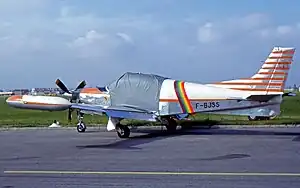SIPA Antilope
The SIPA S.251 Antilope was a low-wing monoplane, seating four or five and powered by a single turboprop engine, developed in France in the early 1960s. It set a number of class records but was not put into production.
| Antilope | |
|---|---|
 | |
| The sole SIPA Antilope exhibited at the Paris Air Show at Le Bourget in 1965 | |
| Role | 4/5 seat turboprop light aircraft |
| National origin | France |
| Manufacturer | SIPA |
| First flight | 7 November 1962 |
| Status | stored in a private museum |
| Number built | 1 |
Design and development
The Antilope was one of the first turboprop powered light aircraft. Apart from its engine, it was a conventional all-metal low-wing machine. The cantilever wing was built around two spars and was a semi-monocoque structure, carrying unslotted ailerons and electrically powered, single slot Fowler flaps. The fuselage was also of semi-monocoque construction. The tail unit included a variable incidence tailplane and a rudder with a trim tab.[1]
It had an electrically actuated tricycle undercarriage, the main wheels retracting inwards into the wings. The cabin had seats for four or five, two at the front and a bench seat behind. In a proposed air ambulance configuration, the Antilope would have carried two stretchers and a medic. Access to the cabin was via a large rear hinged door on the starboard side.[1]
The Antilope was powered by a 665 hp (495 kW) Turbomeca Astazou X driving a 3-bladed propeller, on a long spinner, well ahead of the surrounding air intake.[1]
It first flew on 7 November 1962 and gained certification in April 1964. That autumn, P. Bonneau set six international Class C1c (1000 – 1750 kg) records with it, achieving for example a speed of 432.9 km/h (267 mph) over a 3 km course and reaching an altitude of 10,420 m (34,186 ft). Early in 1965 it flew with a four-bladed propeller and improved on one of its own records. A three-blade propeller was re-installed and the aircraft was exhibited at the 1965 Paris Air Show wearing registration F-BJSS. By mid 1966 development had been completed without a decision to commence production.[1] The production version would have been known as the SIPA S.2510 Antilope but none were built; the prototype (F-WJSS) carried the designation S.251 on its fin.[2]
The sole Antilope is undergoing restoration in a private museum, owned by the Association Antilope, at Montpelier-Mediterranee Airport, in southern France.[3]
Specifications (S.2510)
Data from Jane's All the World's Aircraft 1966-67[1] (projected production variant S.2510, estimated at maximum takeoff weight).
General characteristics
- Crew: 1
- Capacity: 4/5
- Length: 9.015 m (29 ft 7 in)
- Wingspan: 11.11 m (36 ft 5 in)
- Height: 2.60 m (8 ft 6 in)
- Wing area: 16.21 m2 (174.5 sq ft)
- Airfoil: root: NACA 23015; tip: NACA 4411[4]
- Empty weight: 990 kg (2,183 lb)
- Max takeoff weight: 1,900 kg (4,189 lb)
- Powerplant: 1 × Turbomeca Astazou X turboprop, 496 kW (665 shp)
- Propellers: 3-bladed Ratier-Figeac FH 76, 1.92 m (6 ft 4 in) diameter constant-speed propeller
Performance
- Maximum speed: 450 km/h (280 mph, 240 kn) at 6,100 m (20,000 ft)
- Cruise speed: 380 km/h (240 mph, 210 kn) 70% power, at 6,100 m (20,000 ft)
- Range: 2,000 km (1,200 mi, 1,100 nmi) typical max
- Service ceiling: 1,100 m (3,600 ft)
- Rate of climb: 13.5 m/s (2,660 ft/min) at sea level
References
- Taylor, John W R (1966). Jane's All the World's Aircraft 1966-67. London: Sampson Low, Marston &Co. Ltd. pp. 56–7.
- "S.I.P.A. S-2510 'Antilope'". Retrieved 2010-02-27.
- Ogden, Bob (2006). Aviation Museums and Collections of Mainland Europe. pp. 121–122. ISBN 0-85130-375-7.
- Lednicer, David. "The Incomplete Guide to Airfoil Usage". m-selig.ae.illinois.edu. Retrieved 16 April 2019.
Further reading
- Coleman, Herbert J. (24 June 1963). "SIPA Seeks Military Orders for Antilope". Aviation Week & Space Technology. 78 (25): 96–99. Retrieved 18 April 2019AVweek
{{cite journal}}: CS1 maint: postscript (link)